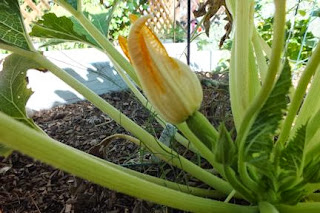Update: This is a story of gardening in the desert. The heat is a challenge, and for the last few years I've kept a small garden on the front porch, including the aquaponics bed. Summers can be brutal, but we find ways to deal with it. (2025)
By the time the temperatures reach 100+ degrees I usually
allow the soil beds to rest, covering them with cardboard or some sort of mulch.
I water to keep the perennials healthy; the herbs and grape vine do
fine over the summer. The soil itself is watered less frequently. The goal is
to keep it moist, but not wet, and continue to provide an inviting environment
for microbial communities.
 |
| Nearly Empty Garden Beds in July |
This summer, though, is a little different. I, and numerous
other gardeners, didn't have the wildly successful bounty of fruits and veggies
to which we have become accustomed. While many in other parts of the country
are still waiting to harvest their tomatoes, cucumbers, summer squash and
assorted lettuces, we in the desert are done. We harvest in late spring, before
the temperatures are too high, and the plants cease to produce.
But somehow, the cycle got tilted off its axis this year,
and other gardeners tell me their tales of woe:
- My squash never even flowered
- My tomatoes took too long to ripen
- My cucumber plants didn't even try this year
- Powdery Mildew is the bane of my existence
You get the idea. But
like most gardeners, I lament the poor season and prepare for the next,
confident that the next harvest will be better.
 |
| Pumpkin Seedling in a Pot |
But as I was starting to start seeds in pots, I was struck
by how many seeds I had, and that many may be 'past their prime'. So I thought,
"Why not throw caution to the winds, and throw a bunch of these seeds into
the garden and see what happens?"
I walked among the beds, poking holes in the soil and
dropping in seeds. I made shallow trenches with a stick and sprinkled in seeds.
Some seeds were simply sprinkled on top of the soil and left to the elements. I didn't even put in garden markers. Just
planted seeds.
Storing Seeds
Seeds are particular about their environment. To maintain
its ability to germinate over a period of time, a seed must be in a cool, dry
environment, one practically void of oxygen. Once moisture and oxygen enter the
environment, the seed wants to sprout. But if the seed hasn't been properly
stored, it may fail to germinate, even when planted in an environment of near
perfect conditions.
For example, if seed has been stored in a shed in which
temperatures may drop to freezing and rise to the blistering hell that is
Phoenix in the summer, it may no longer be viable. I've kept many of my seeds
in air tight containers, the kind used by crafters to separate their beads. But
I also have some in packets in a plastic container. Some packets are opened,
some are not.
 |
| Seeds in Bead Containers |
A good way to store seeds is to add a thin layer of rice or
powdered milk to a glass jar, place the seed packet in the jar, seal it and put
the jar in the fridge. If the seeds aren't in packets, cover the rice or
powdered milk with a bit of cheesecloth or tissue, and pile in the seeds. Be
sure to mark the jar to note what kind of seeds are inside.
I haven't done any of
this, so I don't know how viable my older seeds are in terms of germination,
and if they have the potential to produce. But I can't conceive of throwing
away seeds without giving them a chance to grow, to thrive, to bear fruit. So
throughout the summer, I'm going to keep adding seeds to pots, and to the soil
beds, and to the aquaponics grow bed.
The few packets that I've purchased within the last few
months I'll store in glass jars, and find a place for them in the fridge. It's
the practical thing to do.
Free Style Gardening
 |
| Okra Seedling from Older Seed Packet |
Other than that, though, I'm thumbing my nose at the searing
summer heat and arid winds, and last season's poor harvests, and planting seeds without rhyme or reason. I'm working without a plan, without a net,
without a chart downloaded from a Master Gardener website that tells me when to
plant, where to plant it and what other plants to plant it with.
It's free style gardening in the summer time. And I have no
idea what my gardens will grow.









.JPG)





.JPG)
.JPG)
.JPG)

.JPG)
.JPG)
.JPG)


.JPG)